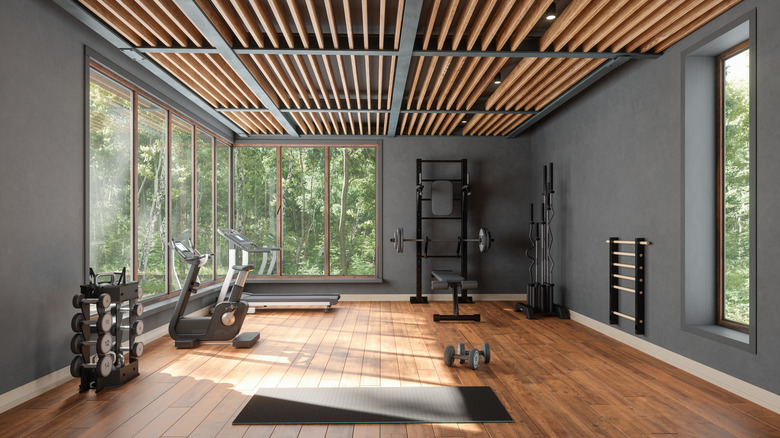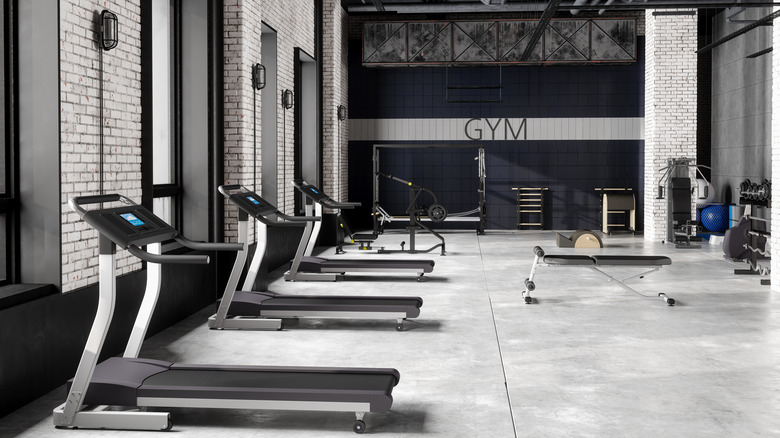8 Sneaky Ways Gyms Trick You Into Spending More Money
Like your physical health, your financial health relies on your ability to avoid fads and do the practical, tried and true work required to maintain progress. Taking a good look at how your gym may be costing you more money than it should is a great way to check your financial health without raising your heart rate. Statista reported that the health and fitness industry, including gyms, made $30.6 billion in the U.S. in 2022. A 2023 estimate adds a markup of an additional $200 million. Memberships and fees provided the lion's share of revenue for gyms, with some 30 thousand gyms and 64.2 million gym memberships providing the stimulus for those numbers.
Personal trainer sessions, co-ed workout classes, retail, and meal planning provide even more streams of revenue for gym owners. They need all of that money, too, considering the average cost of running a successful gym can set an owner back anywhere from $37,000 to $49,500 per month with a dozen employees. Still, with the average gym in the U.S. in 2019 posting $846,827 in revenue with 15.5% to 20% of that coming in as profit, gyms are doing well despite the cost of doing business.
Gyms are employing several tricks to convince you to spend more money than necessary. Here's what to watch out for.
Juice bars and beverages
Working out leads to sweat, which leads to dehydration. The big rule of thumb is to hydrate. Gyms have made that easier with the onset of juice bars and beverages offered onsite, meaning you never have to leave the gym to get a refreshing vitamin-fueled drink. In the same way casinos pump oxygen into rooms to keep the gamblers energized and at the tables, gyms have added drinks made from natural ingredients called functional beverages — like coconut water and protein-packed fruit and veg smoothies — to energize their membership and keep them active between sets.
The thing is, some of the drinks being sold to members aren't that good for you once you look at the incredibly high caffeine content in many energy drinks. Aside from health risks that include insomnia and elevated heart rates, even sports drinks without caffeine in the ingredients are a waste of money for the simple reason most people don't need them for adequate hydration. Water works just as well, and a gym worth your membership ought to have fountains to easily and inexpensively replenish your water bottle.
Unlimited classes vs. pay as you go
Unlimited classes sound like a great addition to any membership package. Gyms recognize the majority of their revenue will come from memberships and attempt to add in extras, including unlimited classes, into their service offerings. The psychology behind unlimited classes is the feeling you are getting a great deal since you can access classes whenever you want. Of course, if there are two classes in a day and you can only attend one, or the classes you want to take happen on days or times that don't always work with your schedule, you'll end up leaving classes and money on the table. Gyms will oftentimes slip in class sign-up rules in the fine print of your agreement that actually put limits on your unlimited classes to Jedi mind trick you into not noticing.
The typical group workout class runs anywhere from $30 to $50 per class. If you were to take classes an average of three times per week, that's $90 to $150 per week, whereas the average monthly membership with the addition of unlimited classes can run you around $600. Doing the math, if your classes are on the lower end or you intend on taking just one or two classes per week, paying as you go can save you just over $1,000 per year. Paying by class puts the power, and money, back in your hands.
Personal trainers
Personal trainers are part of the expected experience of joining a gym. While they can be valuable assets in terms of motivating you with a tailored plan to help you reach your fitness goals, they are also expensive. That's because, in 71% of gyms, group classes alone average attendance of only one to four members, with the goal being around six. But even with six members in every class taking unlimited classes three to four times a week, the gym nets about $72.20 per class. Personal trainers can make around $74 per hour for a gym per member, making their existence in a gym a necessity.
Online personal training requires the purchase of an app and can cost from $15 a month for group classes to $100 to $400 per month for one-on-one training. Even the latter is far cheaper than a gym membership plus the addition of sessions with a personal trainer. For instance, the best online personal trainer for live virtual training according to SI, Flexit, offers four 30-minute sessions for $134, or $33.50 per session up to 12 60-minute sessions at $734.40, or $61.20 per session. Still, undercutting the cost of a gym membership and personal training at both the high and low end. If saving money while getting fit from the sanctity of your home doesn't motivate you, a personal trainer at the gym won't do it either.
Membership commitments that profit from your absence
Perhaps the most obvious point in this list is that membership exists to give you regular access to a gym. Regardless of your membership and what extra services you are paying for, you can only ever get your money's worth if you are there. In a Berkely research paper by Stefano Dellavigna and Ulrike Malmendier entitled Paying Not to Go to the Gym, the researchers found that people who chose monthly membership with flat fees over $70 averaged just over four visits per month and paid more money for the privilege than if they had paid $10 per visit with a 10-visit pass. Worse still, members on that monthly contract tend to be 17% more likely to retain their membership over a year, leading to around $600 of lost savings over the term of their membership.
The Better Business Bureau (BBB) suggests trying out limited trial offers to get a sense of whether you can stay committed to your goals or even just gauge how much you like the gym. Not giving into a manufactured sense of urgency or being pressured to join a gym, being aware of the small print in your contract and budgeting accordingly can also help you avoid paying gyms for your absence. If you have trouble sticking to your gym routine, commitment therapy can activate the subconscious mind, which dictates some 95% of things we do every day.
Cancellation fees
If you've fallen into the trap of joining a gym and it's not working out, the next logical step, canceling your membership, could cost you even more money on the way out the door. Cancellation fees are often the last thing anyone thinks of when joining a gym but it remains a reality with the high turnover present at gyms. Pay attention to the conditions of your contract and consider options like medical reasons, with the assistance of a doctor's note, or moving away, providing proof of your change of locale, with your cancellation request. Ask questions about cancellation fees before you join so you understand loopholes and penalties for cancellation before it becomes a factor.
With enough notice, some gyms allow for a pause on your membership as long as you commit to a continuation of services after the pause period. Legally speaking, if the conditions of cancellation weren't explained to you before you joined the gym, you may also have a way out without having to pay a fee. The Consumer Federation of America suggests going above your local gym management and bringing your request to corporate headquarters, which will be much more invested in the brand's good name than the individuals working for them. Also, if your gym has significantly altered any part of the services they contractually committed to, you may be able to use this as an excuse to cancel your membership without paying a fee.
Paying for amenities you don't need
Do you really need towel service or can you just bring your towel to the gym? If you're paying extra for gym towels, you may want to consider doing the latter. Several amenities including Wi-Fi, equipment, fitness classes, pools, and saunas can all be factored into your membership fees. So, to mitigate some of that financial burden, think about what your goals are ahead of time and be brutally honest about what amenities you actually need. For instance, if you want to use the pool, research community pools or community centers in your area that may have a pool you can access for a fraction of the cost. Most community centers with pools also have amenities like basketball or tennis courts you can integrate into your fitness plans.
In terms of equipment, you may want to think about a home gym. With the purchase of some dumbbells, a yoga mat, and a fitness training app you may not need to go to the gym for the use of equipment. If classes are part of your membership and you don't have an interest in them, ask for that to be removed from your membership fee. Just because the cost is baked into your membership, doesn't necessarily mean you have to pay for something you have no intention of using.
Aesthetics
They say you eat with your eyes, but you probably didn't know you also work out with them. The design elements in a gym can actually have an effect on your desire to be a member. According to Sargenti Architects, natural lighting in gyms is enhanced in a way that energizes you while gentler lighting works to calm your mood for activities like yoga. Certain colors trigger behavioral responses in people. Bold colors in the equipment area may make members feel powerful while neon in a cardio or spin class can provide a jolt to your senses and help supercharge your workout. All the basics of aesthetics like air circulation and how clean the gym appears can also manipulate your experience of a gym. The importance of design into the consistency of design and equipment across a chain, a great layout that takes space, flow, and safety into consideration, and effective decor, including the previously mentioned lighting and color scheme, can have a positive impact on your workout — but you may be paying more for it than necessary.
Cross-branded retail
Sportswear is expected to reach $108.7 billion by the end of 2025, and gyms want their share of the pie. Fitness clothing, nutritional products, accessories like boxing gloves or water bottles, and even health and beauty products have all made their way to gyms in the last few years. Part of that sales strategy includes prominent placement of these items, usually in the same places members arrive or exit, and an easy way to pay for items that can also include adding the purchase to your monthly membership fee.
Aside from the usual, gym-branded beauty products tailored toward active lifestyles are all the rage. Pilates chain New York Pilates offers merchandise like a facial cleanser, body wash, deodorant, and shampoo. SoulCycle has high-end luxury items from Le Labo and R+Co for their members. The Los Angeles Times points to the merging of fitness and beauty brands like Equinox, who partnered with Kiehl's on a locker room cross-promotion back in 2009 and recently launched its fitness-related beauty brand with everything from blush to soothing facial mists. Influencer culture also has a hand in the merging of fitness and the nearly $4 trillion wellness industry, with social media celebrities like Kayla Itsines' beauty regimens attracting as much attention as their workouts.
Don't turn your gym day into a spa day, especially if it's going to have you spending $40 for a bottle of shampoo.








